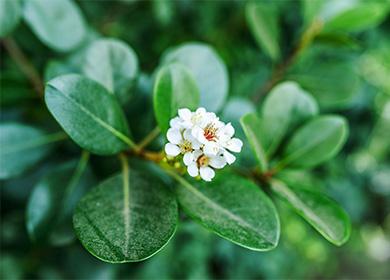The content of the article
Unpretentious peperomia can be a voluminous shrub that adorns a winter garden. Or a shrub that sits in a voluminous tub in the bright corner of the living room. And it can be an ampel plant, effectively hanging down from a cache-pot on a veranda or a loggia. It all depends on how caring and how often the owner cuts it off. A distinctive feature of the evergreen southerner is juicy thick stems and leathery leaves of a deep green color. The shape of the leaves varies from species to species and varies from soft, heart-like to fluffy corrugated.
Types of Evergreen Perennial
There are a great many types of peperomia - more than 1000. But the main ones, often found on domestic window sills, are only 11. The features of each popular species are described in the table.
Table - “Domesticated” types of peperomia
| View | Features |
|---|---|
| Tupolate | - Fleshy leaves, egg-shaped; - from 8 to 12 cm in length; - the color of the leaf depends on the variety (from dark green to milky) |
| Puckered | - On the leaves, pronounced brown veins, concave on the front side; - blooms very beautifully |
| Silver | - Leaves grow from rhizomes; - color of petioles reddish; - on the leaves, pronounced veins separated from each other by white stripes |
| Gray-haired | - Height up to 1.5 m; - stems and leaves are covered with hairs |
| Pleasant | - Miniature oval leaves; - shoots are covered with hairs; - the front plate of the leaf is green; - the reverse side has a reddish tint |
| Creeping | - Ampel flower; - the leaf has a flattened egg shape; - depending on the variety, the leaves may have a different color |
| Marble | - Marble color of a leaf; - leaf shape - a small heart; - brownish veins on a leaf |
| Multi-spotted | - Has long inflorescences; - brown veins on an egg-shaped sheet |
| Reddish | - Ornamental plant; - oval small leaf; - the upper part of the leaf plate is green; - bottom - red |
| Clubly | - "Sedentary" fat leaves; - sheet length - about 15 cm; - the shape of the top of the sheet plate is dull; - lilac border along the edge of the sheet |
| Velvety | - A round leaf (pubescent or bare - depending on the variety); - flowers in the form of spikelets; - stems straight reddish, covered with hairs |
Peperomia is a favorite of florists and landscape designers. Due to the variety of species and varieties of this evergreen plant, the overlords of bouquets create floral arrangements that admire their beauty. Most often, shoots of peperomia with leaves are used, but some species and varieties are grown, including for the sake of flowers.
What to look for when buying
Just knowing how to care for peperomia after a purchase is not enough. When choosing an instance in a flower shop, pay attention to three nuances.
- Foliage color. The selected plant should have a saturated, maximum bright color of the leaves. It is good if there will be patterns on the leaves. The patterned shrub looks even more interesting in the interior.
- The quality of the stem. Visually, the stem should be healthy. Any damage to the shoots is an alarming call to refuse the selected instance.
- Lack of rot at the root. Gray moss at the base of the root is a clear sign of a rotting root system. A sick plant in the house is useless, given the risk of the disease moving to other indoor flowers.
Peperomia care at home
Growing peperomia at home is based on two "NOT": do not over-moisten and do not expose to the sun. However, there are others - secondary, but also no less important recommendations for care.
Lighting
To correctly select the lighting for the evergreen southerner, you need to look at the color of its foliage. If the leaves are even green, feel free to send a pot of peperomia to the northern windowsill. But such locations are not suitable for variegated specimens - they have a better view of the West or East.
Protection from the destructive direct rays of the sun is required peperomia, regardless of type and variety. Ultraviolet light can damage the sheet plate. First, the leaves turn yellow, and then completely fall off due to a sunburn.
Temperature
Tropical plant - it is also tropical in Africa. Therefore, the bush does not like the cold and does not tolerate a through stream of air. Optimum for an evergreen flower are considered 22 ° C in the summer and 16-19 ° C in the winter. In the frosty season, a pot with a southerner cannot be kept on a cold windowsill. Reviews of experienced gardeners indicate that peperomia freezes when the temperature of the substrate in which it sits drops below 15 ° C.
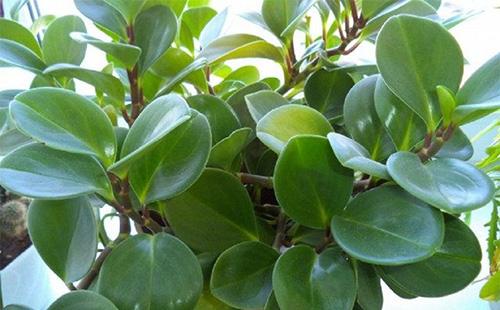
Humidity level
Peperomia doesn't care how wet it is in your home. Despite the fact that in nature this evergreen shrub grows in conditions of high humidity, dry air is not able to destroy it. Varieties with dense green leaves survive well without additional moisture, even during the heating season. But specimens with a delicate sheet plate dry air tolerate somewhat worse, but not critical. In summer, peperomia can be sprayed by bathing about once a week.
Features of watering
Peperomia, like a camel, accumulates moisture in its fleshy leaves. The water supply of the plant is sufficient. Therefore, the short memory of a gardener who forgot to moisten the soil, he is not afraid. In the summer, watering should be moderate. Its average frequency is once every two weeks. In the cold season, watering should be much less common. Then, when the substrate in the pot dries out completely.
Top dressing
In winter, the evergreen southerner needs to be fed no more than once a month. With the advent of heat, soil fortification should be increased and carried out once every half a month.To do this, it is enough to purchase ordinary fertilizer, which is designed for decorative and deciduous indoor flowers.
Transfer
The root system of the southerner is underdeveloped. Therefore, a large pot is not worth buying for her. Peperomy transplantation is carried out no more than once every two years, after flowering. It is important to properly organize the drainage (about 6 cm) and properly prepare the soil. All five of the “ingredients” listed below, ideal for peperomy, should be taken in a ratio of 2: 2: 2: 2: 1. Soil recipe:
- garden land;
- humus;
- turf land;
- peat;
- coarse sand.
Peperomia grows so slowly that some disturbing gardeners seem to not grow at all. A sure sign that the flower needs a new "house" is the roots that have overcome the drainage and almost climbed out of the pot.
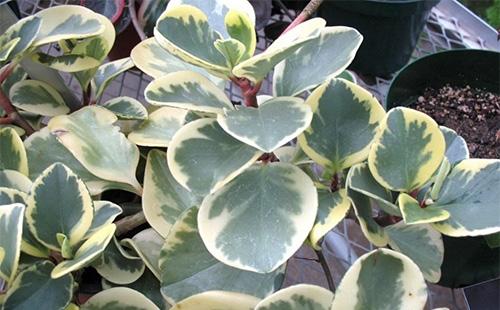
Pruning
If you are chasing a bushiness of a plant, you should know how to form peperomy so that the plant resembles a ball in shape. Each shoot of the southerner should be pinched, removing about a fifth of it. Regular cropping allows you to quickly achieve the desired spherical effect.
3 ways to breed
Propagation of room peperomia is possible by seeds, cuttings and division of the bush. Each of the three methods is easy to implement and highly effective.
Seeds
Features To try this method of "cloning" a tropical beauty in practice, you need to wait until the peperomy fades, and collect the seeds. Take advantage of such planting material will not happen until March. The beginning of spring is considered the most favorable period for planting seeds.
Action algorithm
- We mix river sand with universal soil in a ratio of 1: 1 and fill the substrate for seedlings with a substrate.
- Moderately water the substrate and lay the seeds of the shrub no deeper than 2 mm.
- We cover the forms for seedlings with cling film or transparent glass, creating a semblance of a greenhouse.
- Every day for five minutes we air the seeds by removing the film or raising the glass.
- When seedlings with two leaf plates appear, we plant them in separate small pots.
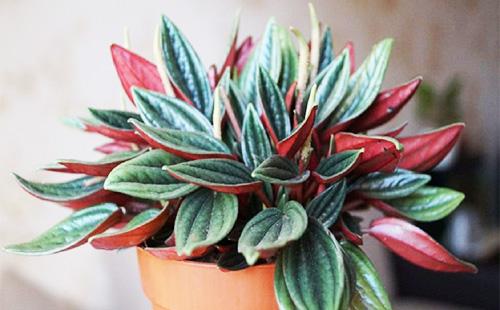
Cuttings
FeaturesDo not be upset if your beauty does not bloom. You have two more effective methods in stock. Cuttings remaining after pruning can also be used as planting material. Before rooting peperomia in the form of a stalk, you need to remove leaves from it and make sure that it has three or more growth points. Eight out of ten cuttings take root without any problems.
Action algorithm
- Disinfect a sharp kitchen knife and cut a few cuttings with it.
- Lower the cuttings in the "Kornevin" for an hour.
- We get from the "Kornevin", sprinkle a cut of the cut with crushed activated carbon and dry the planting material for a day.
- Rooted in moss, sand or water.
- Two months later, we plant in ordinary soil and proceed to the traditional care.
Dividing the bush
Features Reproduction by dividing the bush coincides with a plant transplant, which is carried out in the spring - no more than once every two years. The lush bush can easily be divided into two or three copies. For separation, you need a pre-sanitized kitchen knife.
Action algorithm
- Using a knife, we divide the root system of a plant prepared for transplantation into several parts (depending on the size of the root).
- Sprinkle each slice with crushed chalk or activated carbon powder.
- We plant it in a pot and take care, as usual.
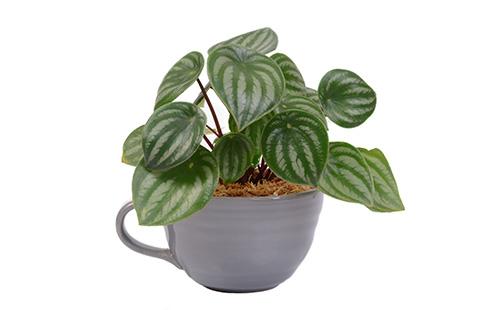
Enemies among insects
Those who know how to care for peperomia, and apply the rules of care in practice, should not be afraid of the attacks of insect pests. But to know about possible enemies is still necessary. The following table will help you understand your symptoms and treatment.
Table - Peperomy pests and ways to combat them
| Pest | Reason for occurrence | Symptoms of defeat | Treatment methods |
|---|---|---|---|
| Mealybug | - Draft; - waterlogging of the soil; - low air temperature | - The formation of white fluffy mass in the leaf sinuses | - Treatment with a cotton swab dipped in an alcohol solution; - insecticide treatment |
| Thrips | - Heat in the room; - critically low humidity | - Appearance of scanty light points on a sheet plate | - Insecticide treatment |
| Spider mite | - dry air; - heat | - The appearance of cobwebs between leaf plates | - Warm shower; - spraying with insecticides |
| Nematodes | - Infection from a neighboring plant | - Treatment with insecticides; - daily irradiation with a quartz lamp (3 minutes) for prevention | - The death of large sections of the leaf; - the leaves turn black and fall off; - the formation of spherical growths on the stems |
| Shield | - dry air | - The formation of brown small growths on the stems | - Insecticide treatment |
If gray rot is found on the basal fragment of peperomia, the plant is unlikely to be saved. The paramount task after the diagnosis of the disease is to isolate the diseased flower from other inhabitants of the windowsill. Most likely, the plant will have to be thrown away, and the pot boiled with a pallet, in order to prevent the spread of rot.
Flower Disease Stories
In general, the evergreen shrub firmly tolerates all the mistakes made by the beginning flower grower during the care process. The plant rarely gets sick. But aptly. The table shows the five most common problems. Any of them can be solved by correction of care.
Table - Diseases of peperomia
| Disease | Reason for occurrence |
|---|---|
| Plant sheds lower leaves | - Inadequate watering |
| Brown spots appear on the leaves. | - Draft; - cold |
| Leaves fade, gray spots form on them and stems | - The plant has decayed due to overflow |
| The leaf plate is deformed, the leaves fade | - Sunburn |
| A healthy-looking leaf massively falls from a bush | - The plant is frozen |
Americans, who liked peperomia at first sight, nicknamed it in their own way - "friendly family." And the followers of Feng Shui philosophy could not pass by and picked up this idea, which, obviously, was in the air. According to this Eastern teaching, peperomia care in a pot is shown to newlyweds and families in which spouses cannot find a common language. They say that the plant instantly absorbs negative emotions, and instead emits positive vibes into the air, which push people towards reconciliation and give a good mood.
Reviews: “The main thing is not to spill the mouse tail!”
Peperomia are one of the best decorative and deciduous collection plants. Firstly, because they are mostly medium-sized plants. Secondly, very diverse in texture. Thirdly, there are a lot of them (only I have 36 of them!).Fourthly, they are very easy to care for and accessible even to a novice. Fifth, their cute unpretentious flowers are very original))) Sixth, many of the peperomies can withstand the shadow, and some grow beautifully in the sun. There are even succulent peperomies. Seventh, they are perfectly propagated by stem and leaf cuttings.
raccoon04, http://forum-flower.ru/showthread.php?t=613
Of the peperomia, I have the blunt-leaved peperomia (Peperomia obtusifolia) and the Kirsten variety of marble peperomia (P. marmorata ’Kirsten’). P. stupid appeared at me last summer, thanks to my mother. It took root easily and flourished in the past and this year. Peduncles long 15-20 cm, and similar to rat tails. This year it has grown, such a large one, and takes up a lot of space in breadth, it can be grown in limbo.
Asio Otus, http://floralworld.ru/forum/index.php?topic=118.0
This interesting plant - peperomia - has settled on my windowsill since the end of summer. Due to a lack of light, he was discounted to 50 rubles at the flower shop, and he had to take on the mission to save him. When I brought him home, he quickly came to his senses, from which I made the following conclusions about this plant: 1. Unpretentious: does not require special attention and care. Watering - well, forgot to fertilize - will survive. You can not spray, well tolerates room air. 2. Do not fill it: the leaves immediately become soft. From the overflow, the plant may die. I try to water all my plants often and little by little. 3. It grows better without a bright sun: on the east or west side, and not in the south. 4. You can transplant into shallow pots: peperomia roots, like grass, are located shallow. Peperomia got its second name because of its spike-shaped inflorescences - “mouse tails”.
sve555, http://irecommend.ru/content/o-myshinom-khvostikeр
